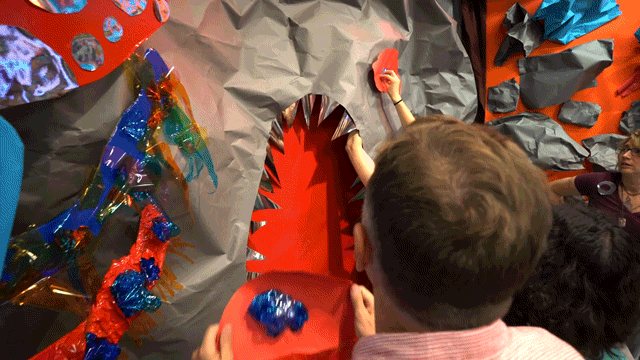Whoop Dee Doo is a non-profit organization that puts on family-friendly workshops and live performances in the spirit of cable access variety shows in collaboration with various local youth programs, art institutions, and other community organizations nationally. Kansas City based co-founders and hosts Matt Roche and Jaimie Warren involve members of the local community through the ideation, construction and performance phases of each show with the help of artists from various disciplines, “from science teachers and Celtic bagpipers to traditional clogging troupes, West African dance teams, Tibetan throat singers, bodybuilders, barbershop quartets, and punk bands” (src), to create a platform that removes the various social, cultural, or economic barriers existing among members of each local community it performs in, as well as a stage for artists to perform; essentially fostering “unique collaborations between unlikely pairings of community members that ultimately blossom into exceptional and meaningful interactions.” (src)
Whoop Dee Doo could be described as socially engaged art because each performance engages directly with the various groups within the communities it’s attempting to foster communication/collaboration among, as a form of communicative action, rather than performing separately from the community as a form of symbolic practice. Although it may not provoke “critically reflexive” dialogue as much as it may create undisputed harmony among the involved groups, Whoop Dee Doo is a community-building mechanism by way of constructing a new temporary social group through this unique, weird, funny, engaging experience they share together. Though, the experience is temporary — what lasting effects are there within these communities, if any? I imagine through targeting the children of each community, the lasting impact is likely greater but perhaps not directly observable. Perhaps Whoop Dee Doo is also catalyzing critical discourse and further collaboration across unexpected cultural boundaries within the art world as well, particularly through the artists who’ve performed on Whoop Dee Doo from the local, or larger “high-art” community.





The high-school-play-meets-off-Broadway set designs convey handmade, DIY sensibilities and an absence of inhibitions as expressed through the vibrant and almost absurd use of colors and textures. This style reflects the chaotic and unexpected mash-up of participants from across social or cultural boundaries who become inextricable parts of the temporary Whoop Dee Doo world, and especially obfuscates the boundaries between high art and that which is not traditionally considered so. To me it’s simultaneously successful as a critically reflexive work of art as well as a party. In a way, it’s success as a critical piece is driven by the core party ethos of bringing communities together through the prospect of having fun.